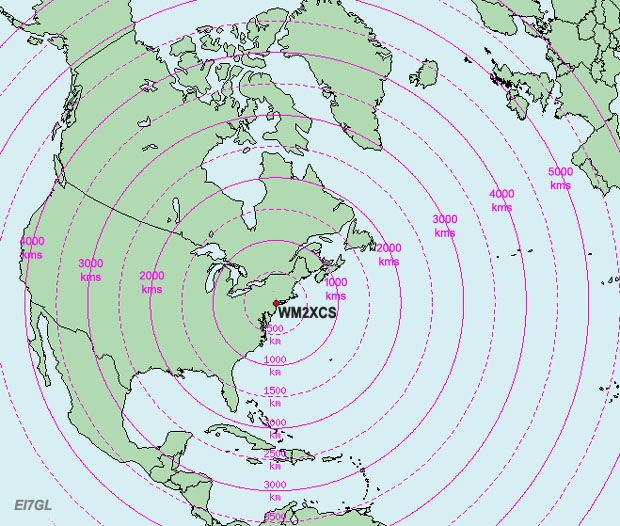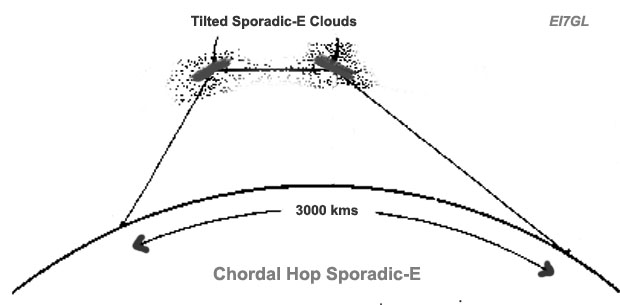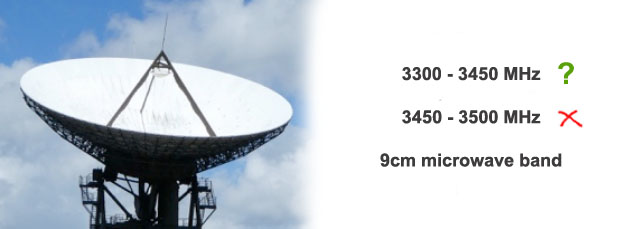In 2021, seven US stations and one Canadian station were given experimental licenses for the 40 MHz band. Several are now active and using the WSPR beacon mode on the band.
This post covers the reception reports for each station in North America for January 2022.
Canadian experimental station CBG209: To allow the callsign to be recognised by WSPR, the callsign was reversed and 902BGC was used.
The openings for the month of January are shown above and I have listed the openings below with the reports under 200kms filtered out. I also removed multiple reports for the same station for the same opening. The power is listed as 10 watts.
Local (y-m-d) TX txGrid RX rxGrid MHz W SNR drift km
2022-01-15 17:32 902BGC CN89 WM2XCC DM13ji 40.663524 10 -22 0 1856
2022-01-12 05:14 902BGC CN89 W3PM EM64or 40.663509 10 -27 0 3365
2022-01-12 04:54 902BGC CN89 WB6HYD CM87xi 40.663524 10 -27 0 1351
2022-01-12 04:54 902BGC CN89 W7IV CM95qn 40.663525 10 -23 0 1560
2022-01-12 00:14 902BGC CN89 WM2XCC DM13ji 40.663522 10 -29 1 1856
2022-01-04 15:40 902BGC CN89 WM2XCC DM13ji 40.663522 10 -13 0 1856
2022-01-03 18:00 902BGC CN89 WM2XCC DM13ji 40.663521 10 -26 1 1856
2022-01-03 17:50 902BGC CN89 WB6HYD CM87xi 40.663524 10 -20 0 1351
2022-01-03 17:40 902BGC CN89 WB6HYD CM87xi 40.663524 10 -21 0 1351
2022-01-02 09:18 902BGC CN89 WM2XCC DM13ji 40.663523 10 -17 0 1856
Even though it's mid-Winter, there seemed to have been five distinct openings. Most of the signals can be accounted for by mid-Winter Sporadic-E or possibly Auroral-E propagation but the one that really sticks out is the 3365km opening to W3PM in Alabama.
The maximum distance for one hop Sporadic-E is about 2200kms. As it occurred near the end of an opening, it was probably due to double hop / chordal hop Sporadic-E.
WM2XCW in Washington State: Just local reports for this station during the month.
Local (y-m-d) TX txGrid RX rxGrid MHz W SNR drift km
2022-02-01 22:16 WM2XCW CN88 VE7NZ CN89 40.663552 10 12 0 111
2022-01-13 17:50 WM2XCW CN88 VE7SKY CN89 40.663467 10 10 0 111
2022-01-13 01:30 WM2XCW CN88 VE7RPX CN89lh 40.663531 10 -19 0 93
2022-01-12 21:00 WM2XCW CN88 VE7DH CN89nf 40.663544 10 -4 0 84
2022-01-12 20:50 WM2XCW CN88 KC7GVU CN88kb 40.663531 10 -29 0 47
2022-01-12 20:44 WM2XCW CN88 CGB209 CN89li 40.663529 10 -16 0 97
WM2XAN in Michigan: This one is listed as 100 watts.
There seem to have been four openings during the month and all the distances are typical of single hop Sporadic-E.
Local (y-m-d) TX txGrid RX rxGrid MHz W SNR drift km mode km/W spotQ version
2022-01-17 16:30 WM2XAN EN74oh W4WLO/S11 EM50vo 40.663449 100 -26 -4 1553
2022-01-16 01:54 WM2XAN EN74oh W4WLO/S11 EM50vo 40.663445 100 -24 -4 1553
2022-01-15 23:44 WM2XAN EN74oh AE5LY/2 EL29hb 40.663491 100 -27 -4 1937
2022-01-12 04:02 WM2XAN EN74oh W3PM EM64or 40.663469 20 -10 -4 1079
2022-01-11 16:24 WM2XAN EN74oh WM2XEJ EM83ji 40.663485 100 -7 -3 1226
2022-01-11 06:20 WM2XAN EN74oh WM2XEJ EM83ji 40.663487 100 -22 -4 1226
2022-01-11 02:56 WM2XAN EN74 VE1PYE FN84et 40.66347 100 -18 0 1690
2022-01-10 22:14 WM2XAN EN74 N2OTO EL96wi 40.663894 0.5 -18 -4 2063
WM2XEJ in Georgia: Another listed as 100 watts although it was listed as 10 watts at times.
There seems to have been seven openings during January. Most of them are Sporadic-E but it's interesting to see several in that 300-800km region which is usually inside the Sp-E skip zone.
Local (y-m-d) TX txGrid RX rxGrid MHz W SNR drift km mode km/W spotQ version
2022-01-23 21:30 WM2XEJ EM83ji W4WLO/S11 EM50vo 40.663487 100 -19 0 562
2022-01-20 18:34 WM2XEJ EM83ji WM2XAN EN74oh 40.663527 100 -18 0 1226
2022-01-19 15:10 WM2XEJ EM83ji WM2XAN EN74oh 40.663524 100 -28 0 1226
2022-01-16 00:26 WM2XEJ EM83ji WM2XAN EN74oh 40.663525 100 -19 -1 1226
2022-01-15 23:52 WM2XEJ EM83ji AE5LY/2 EL29hb 40.663522 100 -18 0 1251
2022-01-15 22:56 WM2XEJ EM83ji W4WLO/S11 EM50vo 40.663477 100 -17 0 562
2022-01-15 16:32 WM2XEJ EM83ji W3PM EM64or 40.663503 100 -23 0 364
2022-01-12 17:28 WM2XEJ EM83ji N2OTO EL96wi 40.663522 100 -22 0 833
2022-01-12 14:52 WM2XEJ EM83ji NI4Y EM73 40.663509 100 -28 0 171
2022-01-11 21:02 WM2XEJ EM83ji VE2UG FN35gs 40.66345 10 -25 0 1611
2022-01-11 18:20 WM2XEJ EM83ji N2OTO EL96wi 40.663456 10 -22 0 833
2022-01-11 16:08 WM2XEJ EM83ji WM2XAN EN74oh 40.663464 10 -22 -2 1226
2022-01-11 15:04 WM2XEJ EM83ji KC5LT EM86 40.663454 100 -21 1 348
2022-01-11 06:22 WM2XEJ EM83ji WM2XAN EN74oh 40.663466 10 -6 -2 1226
2022-01-11 06:04 WM2XEJ EM83 N2OTO EL96wi 40.663453 10 4 0 841
WM2XCC in California: Listed as just 2 watts this time.
It seems there were three distinct openings and all were to the cluster of receivers near Vancouver. Again, all typical Sporadic-E distances.
Local (y-m-d) TX txGrid RX rxGrid MHz W SNR drift km
2022-01-11 23:16 WM2XCC DM13ji VE7DH CN89nf 40.663503 2 -25 0 1826
2022-01-11 22:38 WM2XCC DM13ji CGB209 CN89li 40.663489 2 -6 0 1843
2022-01-11 21:46 WM2XCC DM13ji VE7DH CN89nf 40.663503 2 -24 0 1826
2022-01-11 20:16 WM2XCC DM13ji VE7UTS CN89li 40.66349 2 0 0 1843
2022-01-04 15:30 WM2XCC DM13ji VA7MM/A CN89og 40.663537 2 -23 0 1829
2022-01-02 09:38 WM2XCC DM13ji VA7MM/A CN89og 40.663535 2 -22 0 1829
In conclusion: To the best of my knowledge, there is no WSPR activity in Europe at present and the guys in North America are certainly leading the way.
Despite the fact it was January and mid-Winter, there is plenty of evidence of openings on the 40 MHz band. Once we get to May, these openings in the region of 800-2000 kms should start to become a lot more common.
Looking through the full reports for January, most of the signals were buried in the noise and it shows the advantage of using a weak signal mode like WSPR as opposed to just plain CW. If all of these experimental stations had just CW beacons then I certainly wouldn't be writing this post as little or nothing would have been reported.
Some thoughts...
1) It would be nice if more people set up receivers for the band and listened for WSPR signals.
2) We'll have to wait and see if the remaining three experimental US calls have any interest in getting up and running on WSPR.
3) It would be great to see some WSPR activity in Europe as well. Anyone interested??
Links...
1) As always, there is plenty of information about the new 8m band on
my 40 MHz page.































